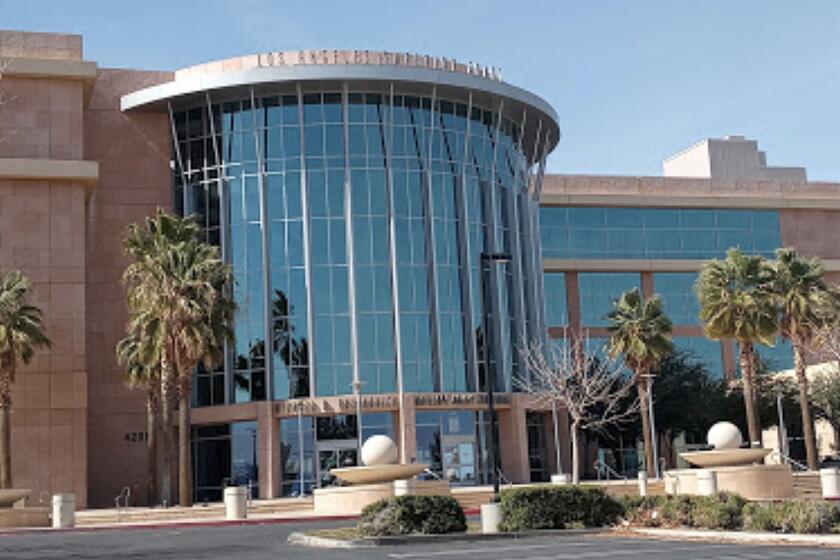Slow-Growth Initiative May Be Scuttled : Orange County’s Supervisors, Activist Try to Avert June Vote
- Share via
Slow-growth activist Tom Rogers met behind closed doors Thursday with each of Orange County’s five supervisors to discuss a plan that could end efforts to put a sweeping slow-growth initiative that has drawn national attention to a vote this year.
The plan to drop the initiative was proposed by former Supervisor Bruce Nestande, and it has the support of several major developers. It calls for a powerful new county agency that would coordinate transportation and development decisions, according to Nestande, vice president of the Costa Mesa-based Arnel Development Co.
Rogers is chairman of the organization that has been attempting to gather the nearly 66,000 signatures needed to qualify the slow-growth measure, known as the Citizens Sensible Growth and Traffic Control Initiative, for the June ballot.
Citizens Advisory Commission
If agreement is reached on dropping that effort, Rogers said, the thousands of signatures already gathered on petitions would be withheld, and a citizens advisory commission would be created to study formation of the new transportation agency.
Many legal questions about that arrangement remain unanswered, and Rogers said Thursday that he is not personally committed to the concept.
“We hold all the cards,” Rogers said. “We’re not giving up anything at this point. But we’re willing to see if some accommodation can be accomplished at the county level that would avoid an expensive campaign that we would surely win, but which would lead to subsequent lawsuits.
“We’ve got a talking paper. He (Nestande) was instrumental in getting the two sides together, but we only have a proposal and no agreement. We’ll just see how serious the county is in solving the congestion problem and go from there.”
Rogers, a San Juan Capistrano rancher, said Nestande accompanied him during four hours of meetings with supervisors in their offices Thursday afternoon.
After those meetings, supervisors would not comment on any specifics in Nestande’s plan but welcomed the opening of direct talks with the slow-growth advocates.
“I’m ready to listen,” said board Chairman Harriett M. Wieder. “They came in here to talk about the possibility of stopping the petition gathering on the condition that we would, under certain circumstances, appoint a task force or commission. I accepted their proposal in good faith.”
Widespread Publicity
Rogers’ initiative has drawn widespread attention as one of the most sweeping growth-control measures ever proposed in the United States. It would condition future development on the ability of roads and public services to handle development, would require additional parkland dedication by developers and would set specific performance standards for police and fire protection.
The initiative effort began last spring, two years after an unusual coalition of liberal and conservative activists formed Orange County Tomorrow, which drafted the ballot measure. Participants included Rogers, a former county GOP chairman and shopping center developer; San Juan Capistrano investment adviser Russ Burkett, a conservative GOP activist; Irvine Mayor Larry Agran, a liberal Democrat; Laguna Beach Councilman Robert F. Gentry; Irvine lawyer Gregory A. Hile; Costa Mesa Councilman Dave Wheeler and Laguna Beach lawyer Belinda N. Blacketer, who represents Laguna Greenbelt Inc.
Developers, led by the Building Industry Assn., have strongly criticized the initiative but have mounted no official campaign to defeat it. Recently, however, the association has been raising money for a legal fund and has instituted an advertising campaign defending the construction industry.
Rogers said more than 60,000 of the 66,000 signatures needed by Feb. 9 to qualify the initiative for the countywide ballot in June have been collected, and he added that “the momentum is building.”
Before committing himself to the plan, Rogers said, he will seek the advice of initiative supporters at a meeting Saturday. If there are strong objections then to pursuing a compromise with the supervisors, he said, “we file the signatures.”
Nestande said he believes Rogers has the legal authority to withhold the signatures on his own but acknowledged that the Board of Supervisors would be urged to seek legal advice on that issue from County Counsel Adrian Kuyper. Because those who signed the petitions were told that they would be submitted to the registrar, there is some doubt about the legality of simply abandoning the effort.
Nestande said he and Rogers had been conferring for months about some kind of a compromise involving the supervisors but did not seek appointments with them until Thursday morning.
“I see this as part of my role as a state Transportation Commission member, for one thing,” Nestande said, “but it’s also because I’m a former board member convinced that the board wants to solve this problem, I happen to know Tom Rogers well, and I’m in the private sector. And that may be a unique combination. I’m not fronting for anyone.”
Nestande acknowledged, however, that several developers had reviewed the proposal and approved it in concept. He would not identify those developers, however. Nor would he name businessmen and politicians he said he also had consulted.
Irvine Mayor Agran said Thursday night that there is a possibility that Nestande’s proposal “may be just a ploy by the developers to have the petition circulators relax at the most critical time of the campaign.”
But Agran added that he “would keep an open mind about these things.”
Nestande’s Proposal
In its preliminary form, Nestande’s proposal calls for the county supervisors to adopt a countywide program for phased development, with transportation improvements similar to the Foothill Circulation Phasing Plan. That plan, approved by the supervisors last year, requires builders to pay for a road network that will cost more than $200 million. Payment will have to be made before the developers complete their projects.
Nestande’s proposal also calls for:
- Board of Supervisors appointment of a citizens commission to recommend action on a proposed new transportation authority that would coordinate traffic plans countywide.
- A proposed half-cent sales tax for transportation projects.
- Possible adoption by the county and all of its 27 cities of a model transportation-growth management policy.
Mistrust Cited
Nestande said he hoped slow-growth advocates understood “what an amazing thing it is to have Tom Rogers and members of the board meeting together, considering the shots that they (the supervisors) have taken.”
Rogers has often said that the slow-growth initiative is popular because the public doesn’t trust the supervisors to solve county problems.
One reason he is willing to discuss an alternative to the slow-growth initiative, Rogers said, is the threat of a protracted court battle if it passes.
“It would be foolhardy to fight to the last drop of Orange County’s blood,” Rogers said.
Agran said he had been aware that discussions of a compromise were taking place but did not know the details.
“The idea, of course, is to achieve substantially what the initiative provides,” Agran said. “Ideally, that would have been done through the representative process. If somehow the initiative’s goals can be achieved without the need for an election, that would be wonderful.”
Though he expressed skepticism about Nestande’s motives, Agran said that Rogers is “not the kind of person who would compromise the interests of the troops. I also know he’s playing from a strong hand now, and things are accelerating. I know that Rogers wouldn’t settle for anything less than something equivalent to what’s in the initiative.”
Copies of Nestande’s written proposal have been distributed to several activists who have worked for the slow-growth initiative so they can study it during the next few days.
Blacketer, the Laguna Beach lawyer who helped draft the slow-growth initiative, said Thursday she had received a copy but was not yet familiar with the details and doubts that anything will come of it.
“I don’t think there’s anything wrong with talking, but it may be too late to stop this thing,” she said.
Blacketer said she is still collecting signatures for the initiative and is not as concerned as Rogers about the effect of protracted court battles.
She said a 100,000-piece mailing in support of the initiative is scheduled for early next week.
WHAT SLOW-GROWTH MEASURE WOULD DO The proposed countywide slow-growth measure known as the Citizens Sensible Growth and Traffic Control Initiative would:
Require that new roads generally be sufficient to accommodate traffic moving at certain average speeds during rush hours.
Require that the average traffic delay at new intersections generally not exceed 40 seconds, depending on the availability of left-turn pockets and other design configurations.
Require that congestion generated by new development on existing roads or intersections be offset by traffic improvements paid for by developers within three years of construction.
Set a minimum response time of five minutes for police, fire and paramedics in emergencies, 10 minutes in non-emergencies.
Require more parkland dedications by developers.
Set a minimum flood-control standard requiring that new developments be able to withstand the kind of heavy flooding that occurs on an average of once every 100 years.
HISTORY OF SLOW-GROWTH INITIATIVE March, 1985--Orange County Tomorrow is formed after a meeting at the Balboa Bay Club. Organizers Tom Rogers and Russ Burkett of San Juan Capistrano join forces with Laguna Beach Councilman Robert F. Gentry, Irvine Mayor Larry Agran and others to start discussing a possible growth-limiting initiative.
April, 1987--Lawyers working for Orange County Tomorrow begin drafting a proposed ballot measure.
June, 1987--Orange County Tomorrow unveils its proposed initiative at a Santa Ana news conference. County supervisors individually criticize the measure as unworkable and order staff studies on its potential impact.
July, 1987--A series of 14 closed-door meetings between developers and initiative supporters begins. The meetings lead to a major change: Instead of banning development where traffic can’t meet the initiative’s standards, the new language would allow such development if the builder agreed to pay for certain traffic improvements.
September, 1987--The revised initiative is unveiled, and supporters begin collecting the nearly 66,000 signatures needed to qualify it for the June, 1988, ballot. County officials claim the measure will cost more than $1 billion to implement, a figure strongly disputed by initiative supporters.
December, 1987--Some initiative petitions have to be recirculated because thousands of voters who received the petitions by mail failed to sign them twice as legally required--once as a circulator and again as a citizen seeking to place the issue before the electorate. The Orange County Annual Survey shows that residents favor the measure by as much as a 4-1 margin.
January, 1988--Former Supervisor Bruce Nestande and initiative sponsor Tom Rogers engage in talks about what could be done about the traffic-growth problem if there were no ballot measure. Meanwhile, the county processes agreements with developers that could insulate their projects from the effects of the initiative. And the building industry begins raising money for a legal fund to challenge slow-growth ballot measures throughout the region.
Jan. 14, 1988--Nestande and Rogers hold closed-door talks with county supervisors about a plan to end the slow-growth initiative campaign in return for creation of a new panel that would coordinate transportation and development decisions.
More to Read
Sign up for Essential California
The most important California stories and recommendations in your inbox every morning.
You may occasionally receive promotional content from the Los Angeles Times.










